 General view | |
| Arrondissement | 5th |
|---|---|
| Coordinates | 48°50′40″N2°20′58″E / 48.84444°N 2.34944°E |
| Construction | |
| Inauguration | 1852 |
The Place de la Contrescarpe is a square in the 5th arrondissement of Paris.
 General view | |
| Arrondissement | 5th |
|---|---|
| Coordinates | 48°50′40″N2°20′58″E / 48.84444°N 2.34944°E |
| Construction | |
| Inauguration | 1852 |
The Place de la Contrescarpe is a square in the 5th arrondissement of Paris.
The Place de la Contrescarpe is located along the Rue Mouffetard, at the end of the Rue Lacépède and the Rue du Cardinal-Lemoine. It is at the center of four administrative quartiers or districts; Saint-Victor, Jardin-des-Plantes, Val-de-Grâce and Sorbonne, making it a central point of the 5th arrondissement.
It has a diameter of around forty metres (130 feet) and has a circular traffic island in the middle, which is partly occupied by a public fountain.
Now popular with tourists, it contains many cafés, mostly recent. However, the facades of some buildings still show signs of the square as it used to be.
The square takes its name from the area around the former Rue de la Contrescarpe-Saint-Marcel, now shared between the Rue Blainville and the Rue du Cardinal-Lemoine, which made reference to the word contrescarpe (counterscarp in English), the embankment outside the ditch in front of the Wall of Philip II Augustus.
Ernest Hemingway makes mention of it in his book A Moveable Feast, as he lived for a time just off this square at 74 Rue du Cardinal Lemoine.
Opened in 1852, it was formed by the removal of a cluster of houses between the Rue du Cardinal-Lemoine, Rue Lacépède and Rue Mouffetard. [1] This cluster would today be located adjacent to the café Les Arts, that is, around the eastern part of the square.
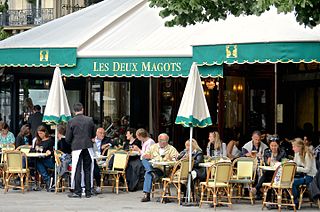
The 6th arrondissement of Paris is one of the 20 arrondissements of the capital city of France. In spoken French, it is referred to as le sixième.
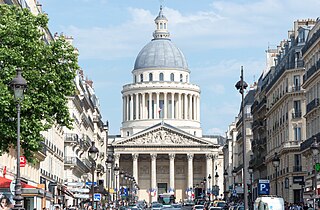
The 5th arrondissement of Paris is one of the 20 arrondissements of the capital city of France. In spoken French, this arrondissement is referred to as le cinquième.

The 2nd arrondissement of Paris is one of the 20 arrondissements of the capital city of France. In spoken French, this arrondissement is colloquially referred to as deuxième. It is governed locally together with the 1st, 3rd and 4th arrondissement, with which it forms the 1st sector of Paris.
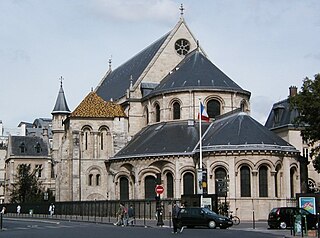
The 3rd arrondissement of Paris is one of the 20 arrondissements (districts) of the capital city of France. In spoken French, this arrondissement is colloquially referred to as "le troisième" meaning "the third". Its postal code is 75003. It is governed locally together with the 1st, 2nd and 4th arrondissements, with which it forms the 1st sector of Paris, Paris Centre.

The 4th arrondissement of Paris is one of the twenty arrondissements of the capital city of France. In spoken French, this arrondissement is referred to as quatrième. Along with the 1st, 2nd and 3rd arrondissements, it is in the first sector of Paris, which maintains a single local government rather than four separate ones.
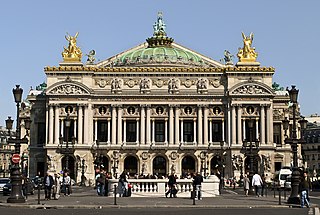
The 9th arrondissement of Paris is one of the 20 arrondissements of the capital city of France. In spoken French, it is referred to as le neuvième.
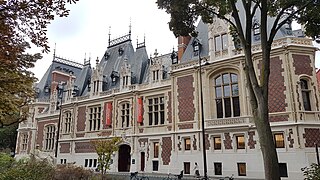
The 17th arrondissement of Paris is one of the 20 arrondissements of the capital city of France. In spoken French, it is referred to as le dix-septième.
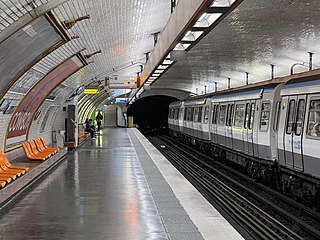
Place Monge is a station on Line 7 of the Paris Métro and located in the 5th arrondissement of Paris.
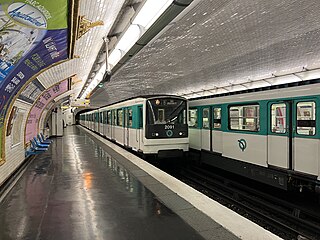
Cardinal Lemoine is a station on Line 10 of the Paris Métro. It is located the 5th arrondissement.

The Montagne Sainte-Geneviève is a hill overlooking the left bank of the Seine in the 5th arrondissement of Paris, France. It was known to the ancient Romans as Mons Lucotitius. Atop the Montagne are the Panthéon and the Bibliothèque Sainte-Geneviève. The side streets of the Montagne feature bars and restaurants, for example, in the Rue Mouffetard.
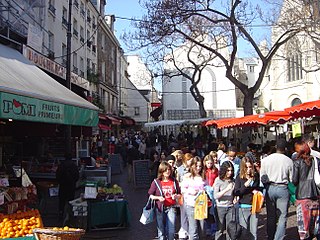
The Rue Mouffetard is a street in the 5th arrondissement of Paris, France.

The Boulevard Saint-Germain is a major street in Paris on the Rive Gauche of the Seine.

Wallace fountains are public drinking fountains named after, financed by and roughly designed by Sir Richard Wallace. The final design and sculpture is by Wallace's friend Charles-Auguste Lebourg. They are large cast-iron sculptures scattered throughout the city of Paris, France, mainly along the most-frequented sidewalks. A great aesthetic success, they are recognized worldwide as one of the symbols of Paris. A Wallace fountain can be seen outside the Wallace Collection in London, the gallery that houses the works of art collected by Sir Richard Wallace and the first four Marquesses of Hertford.

The Boulevard Saint-Michel is one of the two major streets in the Latin Quarter of Paris, France, the other being the Boulevard Saint-Germain. It is a tree-lined boulevard which runs south from the Pont Saint-Michel on the Seine and Place Saint-Michel, crosses the Boulevard Saint-Germain and continues alongside the Sorbonne and the Jardin du Luxembourg, ending at the Place Camille Jullian just before the Port-Royal RER station and the Avenue de l'Observatoire. It was created by Baron Haussmann to run parallel to the Rue Saint-Jacques which marks the historical north-south axis of Paris. It is known colloquially as Boul'Mich' in French.

The Rue Saint-Honoré is a street in the 1st arrondissement of Paris, France. It is named after the collegial Saint-Honoré church, situated in ancient times within the cloisters of Saint-Honoré.
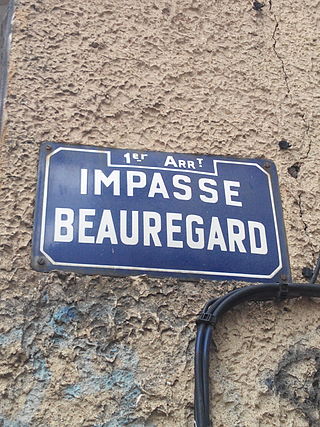
The 1st arrondissement of Lyon is one of the nine arrondissements of the City of Lyon. It is located below the hill of Croix-Rousse and on the north part of the Presqu'île formed by the Saône and the Rhône, the two rivers in Lyon.
This article presents the main landmarks in the city of Paris within administrative limits, divided by its 20 arrondissements. Landmarks located in the suburbs of Paris, outside of its administrative limits, while within the metropolitan area are not included in this article.
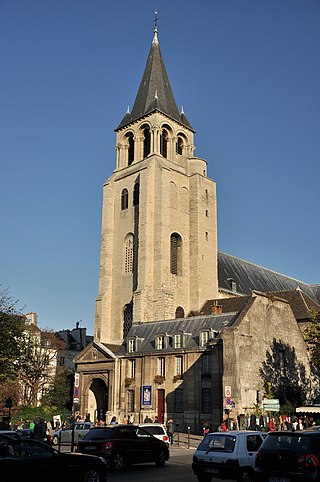
The city of Paris has notable examples of architecture from the Middle Ages to the 21st century. It was the birthplace of the Gothic style, and has important monuments of the French Renaissance, Classical revival, the Flamboyant style of the reign of Napoleon III, the Belle Époque, and the Art Nouveau style. The great Exposition Universelle (1889) and 1900 added Paris landmarks, including the Eiffel Tower and Grand Palais. In the 20th century, the Art Deco style of architecture first appeared in Paris, and Paris architects also influenced the postmodern architecture of the second half of the century.
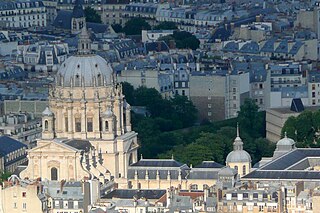
The quartier du Val-de-Grâce is the 19th administrative district or 'quartier' of Paris, located in the 5th arrondissement of the city. Its borders are boulevard de Port-Royal to the south, boulevard Saint-Michel to the west, rue Soufflot, rue des Fossés-Saint-Jacques and rue de l'Estrapade to the north and rue Mouffetard and rue Pascal to the east.